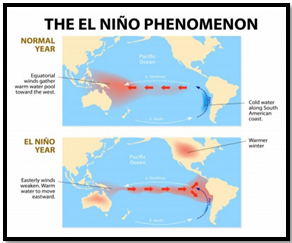WHY KASHMIR IS WITHOUT SNOW
Why in the News?
- Lack of snow in Gulmarg, a prime winter tourism spot, led to a 60% drop in tourist arrivals compared to the previous year.
- The absence of snow affects ski resorts, impacting the local economy and tourism-dependent businesses.
Climatic and Geographical Factors:
- Deficient Winter Precipitation: Jammu & Kashmir and Ladakh experienced an 80% rainfall deficit in December and 100% in January, attributing it to the dry winter.
- Role of Western Disturbances: Declining frequency of Western Disturbances, the main source of winter precipitation, contributes to decreased snowfall in the region.
- Temperature Rise: Rising temperatures, particularly in elevated areas, exacerbate the decline in snowfall, pointing towards the impact of climate change.
- El Nino Influence: The persistent El Niño event in the Pacific Ocean may be an additional factor affecting the global atmospheric circulation, contributing to precipitation deficits.
| Key Terms
El Niño: El Niño is a climate phenomenon marked by warmer-than-average sea surface temperatures in the central and eastern Pacific Ocean. It influences global atmospheric circulation, impacting weather patterns and often causing extreme conditions.
Western Disturbances: Western Disturbances are large rain-bearing wind systems originating beyond Afghanistan and Iran. They bring moisture from the Mediterranean Sea and Atlantic Ocean, causing winter precipitation in northern India. |

 Source: Sikkim express
Source: Sikkim express

